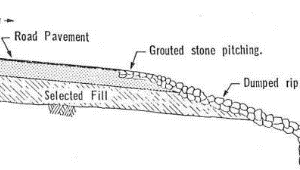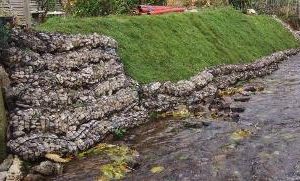Introduction
Bio-engineering is a suite of techniques used for the stabilization of slopes, either road side slopes or quarry sides or gully sides and stream banks. Its distinguishing feature is that it makes use of living vegetation. This is done as stand-alone or in combination with with civil engineering structures and non living plant materials. The aim is to reduce shallow-seated instability slopes on slopes and prevent erosion.
With vegetation being a central elements in bio-engineering, the positive mechanical and hydrological characteristics of plants are employed to secure the stability of the road-side or other slops.
Measures such as stone pitching, gabions and placing soil-cement layer have been used to protect road side-slopes. Bio-engineering is an alternative relatively low-cost and very effective methods, that is particularly suitable in environment with relatively fast vegetative growth.
Side-slope protection with vetiver 1

Vegetation is the cheapest way to protect steep slopes of earth embankments. One commonly used plant is vetiver grass (Chrysopogon zizanioides). This hardy bunch grows naturally across many of the humid parts of the world. It is extremely resilient and can survive deep inundation of up to 6 m (Howell 2008). Vetiver grass is being used as an efficient bio-technology for slope protection in many countries, especially for its attributes: longer life, strong and long finely structured root system, and high tolerance of extreme climate conditions. This technique has recently been employed successfully in certain areas of side-slope protection against rain-cut and wind-induced erosion (Shariful Islam 2013). Vetiver shows successful erosion control in fresh water, brackish rivers, and canals. Moreover, farmers can use it as an animal feed supplement, or to tie up rice seedlings and rice straw (Dung et al. n.d.). Studies show that vetiver application is about eight times cheaper than masonry wall protection and about five times cheaper than the revêtement stone-slope protection system. Thus, vetiver grass plantation for slope protection could be a sustainable, green and cheaper bio-engineering solution (Shariful Islam 2013).
Bio-engineering: turfing and mulching
Over time the range of plants used in bio-engineering has broadened. In many case the preference is to use local plants such as the example from Nepal in table 1.
Table 1. Common plants colonizing roadsides in Nepal. Source: Howell 2008
| Botanical name | Comments | |
| Grasses | ||
| Phragmites vallatoria | Large-leaved tall grass found very commonly on river edges | |
| Cynodon dactylon | Small, creeping sward grass, very common on grazed land; withstands heavy grazing and long inundation, but rooting is shallow | |
| Shrubs and small trees | ||
| Pithecellobium dulce | Small tree, 6 to 10 m tall, small leaves and thorny branches, common on embankments; edible fruit | |
| Eucalyptus sp. | Two main species are most common: E. tereticornis and E. camaldulensis; spindly tree with white bark, up to 15 meters tall | |
| Jatropha curcas | Shrub 2 to 5 m high; grows easily from cuttings; widely used for hedging; shallow-rooted but easy to propagate | |
| Mimosa pigra | Thin, thorny shrub that grows widely on the edges of wet areas and the lower edges of embankments; not liked by farmers who say that it damages young fish during floods and causes infections | |
| Calotropis gigantea | Bushy shrub, large pale green leaves and milky sap, that colonizes embankments; deep tap roots; difficult to germinate from seeds in nurseries | |
| Barringtonia asiatica | Tree that colonizes embankments; very common | |
| Pandanus humilis | Shrub with long thorny, fleshy leaves, 2 to 3 m high, producing many suckers; grows on riverbanks, used for hedges | |
| Combretun quadrangulare | Small tree common on embankments | |
| Acacia auriculiformis | Fast-growing Australian tree often planted along roadsides | |
| Non-grass herbs and other small plants | ||
| Cassia tora | Annual leguminous herb or sub-shrub with purple flowers and small seed pods | |
| Eichhornia crassipes | Water hyacinth, an aggressive, invasive weed in slow-moving waterways | |
| Eupatorium adenophorum | Weedy annual herb with weak, shallow roots | |
| Mimosa pudica | Creeping herb with sensitive leaves; colonizes many bare areas | |

Recently, road projects have used seeding/mulching or turfing (Figure 1) techniques for grassing road embankments (Howell 2008). This is sometimes applied by truck-spraying a liquid mix of vegetative seeds and mulch, Vegetative turfing can be covered by biodegradable geotextiles or geosynthetic nettings. A mixture of straw/wood shavings and cow dung can be used as mulch and applied as a 2.5 cm layer. This is very helpful for embankments less than three meters high. They should be fixed in place with bamboo to avoid being washed away (CSIR-CRRI 2013).
Under the Coastal Embankment Rehabilitation Project (CERP) in Bangladesh, several biological means have been used for protection against embankment erosion. Several grass species have been used for erosion but also as fodder, including vetiver (Vetiveria zizanioides), Napier grass (Pennisetum purpureum), Para grass (Brachiaria mutica), and German grass (Echinoclora grousgali), in addition to other suitable plants like Ipil-Ipil (Leucaena leucocephala), Jhau (Casuarina equisetifolia), and Akashmoni (Acacia auriculiformis) (Islam 2000).
Planting shrubs and thorny bushes along the bank channels provides good protection on the slopes of the embankments (CSIR-CRRI 2013). Planting trees along the side slopes is not recommended because the roots can cause breaching. Tree planting on embankments was not accepted by the BWDB for 30 years. However, the integration of timber and fruit trees, grasses, shrubs, other agricultural elements, and animal husbandry has not been tested systematically in the field on sea-facing embankments (Islam 2000).
Bio-engineering combined with inert techniques
Other methods can be used in combination with vegetation: bamboo, cut branches, banana leaves and other brush mats can be applied as a cover on the slope’s road embankments (Howell 2008). Moreover, wattle fences or brushwood can be placed on the side slope of the embankment with stone protection of the toe (Figure 2); barriers made with bundles using brush work, fascines or wattling (Figure 3); stones mixed with strong timber sections (Figure 4); timber crib walls (Figure 5); reed planting among stone pitching (Figure 6); riprap and reed rolls, or wire netting filled with stone, gravel and clumps of reeds (Figures 7 and 8) (Schiechtl and Stern 1997); and root wads (Figure 9) (SEPA, 2005).



 Brushwood mattresses with toe protection
Brushwood mattresses with toe protection  Fascine bundles
Fascine bundles  Timber crib walls
Timber crib walls  Stone pitching
Stone pitching  Riprap
Riprap  Rock rolls
Rock rolls